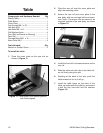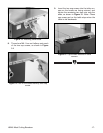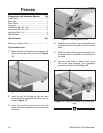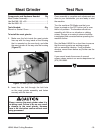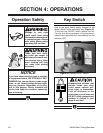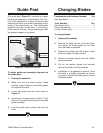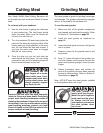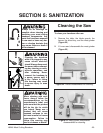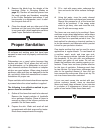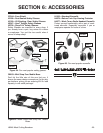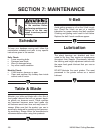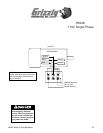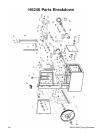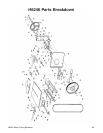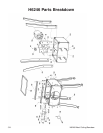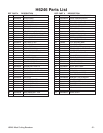
-24-
H6246 Meat Cutting Bandsaw
Proper Sanitation
All surfaces and working parts that have been
exposed to meat must be properly sanitized after
each use.
Dishwashers are a good option because they
sanitize with heat. For all pieces that will not fit
in the dishwasher, or if a dishwasher is not avail
-
able, chemical sanitizers like bleach or iodopher
solution are good options. When using chemical
sanitizers, make sure they are designed to do the
job, and strictly follow the manufacturer’s recom
-
mendations for proper use.
Proper sanitation with chemical sanitizers requires
a process before the actual sanitizer is applied.
The following is an effective method to pre
-
pare an item for sanitation:
1. Gather all the items that need to be cleaned.
Remove the largest particles of foodstuffs
into a garbage container. Rinse all items to
remove as many of the leftover particles as
possible. Set the items aside.
2. Prepare the sink. Wash and scrub all sink
compartments with dish soap and hot water.
Rinse these compartments thoroughly.
3. Remove the blade from the wheels of the
bandsaw (Refer to Changing Blades on
page 21). Sanitize all removed pieces from
the meat grinder and bandsaw, according
to the Proper Sanitation instructions. If you
have access to a dishwasher, use it to sani
-
tize the parts that will fit.
4. Clean the wheels and any other part of the
bandsaw unit that may have been exposed
to raw meat with a direct application sanitizer
(read Proper Sanitation instructions).
3. Fill a sink with soapy water, submerge the
item and scrub the entire surface thorough
-
ly.
4. Using hot water, rinse the newly cleaned
item until all visible suds have been removed.
Repeat this process for all of the items that
need to be sanitized. If the soapy water
starts to get hazy, drain and rinse the sink,
then fill with more soapy water.
The items are now ready to be sanitized. Some
sanitizers require direct applications, while others
are designed to be diluted in water and used to
soak the item for a specified period of time. The
best method for choosing a chemical sanitizer is
to do the research and determine which product
is best for your particular situation.
One simple sanitizer that can be used for many
applications is regular bleach. To use bleach as
a sanitizer, wash, scrub, and rinse your sink.
For all non-porous surfaces (includes all parts of
this bandsaw), fill the sink with one tablespoon
of bleach per gallon of cool water. Do not use
bleach that contains odor masking agents or sur
-
factants. These have not been proven effective
for this type of sanitation. Submerge each item
for two minutes. For large items, submerge each
side for the specified amount of time until you
have covered the entire area. Allow to air dry.
Do
not rinse these items after sanitation!
If your raw meat comes into contact with non-
porous surfaces (wood), clean as described
above and soak these surfaces for two minutes
in a solution of 3 tablespoons of bleach to one
gallon of cool water.
Rinse these items well!



